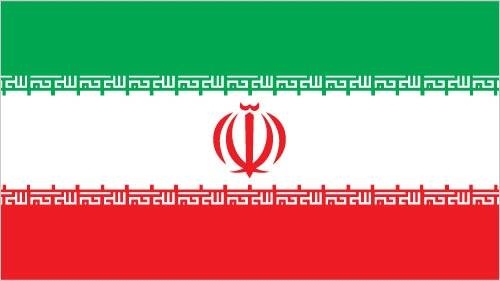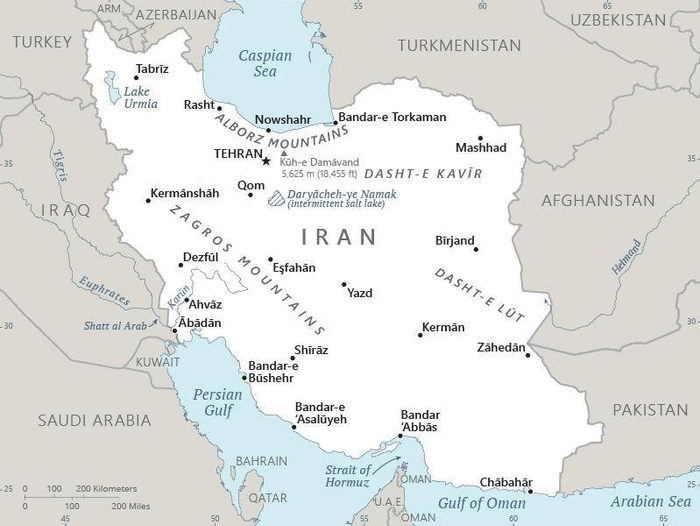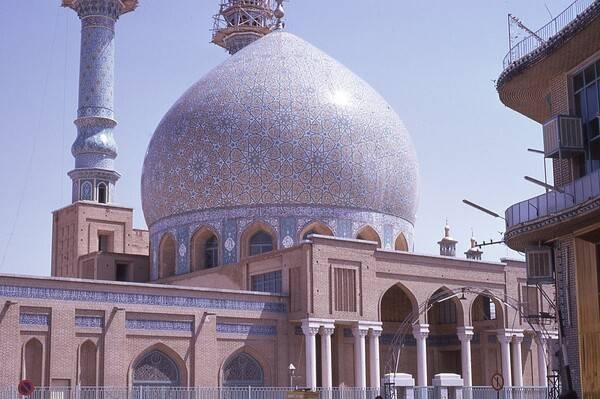142 Iran

Three equal horizontal bands of green (top), white, and red. The national emblem (a stylized representation of the word Allah in the shape of a tulip, a symbol of martyrdom) in red is centered in the white band. ALLAH AKBAR (God is Great) in white Arabic script is repeated 11 times along the bottom edge of the green band and 11 times along the top edge of the red band. Green is the color of Islam and also represents growth, white symbolizes honesty and peace, red stands for bravery and martyrdom.
Flag courtesy of the CIA World Factbook

Map courtesy of the CIA World Factbook

The Shrine of Fatima Masumeh in Qom is considered to be one of the most significant Shi’a shrines in Iran and is visited by pilgrims from around the world. Qom, the capital of Qom Province and the seventh largest city in Iran, is the principle center for Shi’a scholarship in the world.
Photo courtesy of the CIA World Factbook
Government
According to Britannica, Iran is a unitary Islamic republic with one legislative house. The country’s 1979 constitution put into place a mixed system of government, in which the executive, parliament, and judiciary are overseen by several bodies dominated by the clergy. At the head of both the state and oversight institutions is a ranking cleric known as the rahbar, or leader, whose duties and authority are those usually equated with a head of state.
The justification for Iran’s mixed system of government can be found in the concept of velāyat-e faqīh, as expounded by Ayatollah Ruhollah Khomeini, the first leader of post revolutionary Iran. Khomeini’s method gives political leadership, in the absence of the divinely inspired imam, to the faqīh, or jurist in Islamic canon law, whose characteristics best qualify him to lead the community. Khomeini, the leader of the revolution (rahbar-e enqelāb), was widely believed to be such a man, and through his authority the position of leader was enshrined in the Iranian constitution. The Assembly of Experts (Majles-e Khobregān), an institution composed of ʿulamāʾ, chooses the leader from among qualified Shiʿi clergy on the basis of the candidate’s personal piety, expertise in Islamic law, and political acumen. The powers of the leader are extensive; he appoints the senior officers of the military and Revolutionary Guards (Pāsdārān-e Enqelāb), as well as the clerical members of the Council of Guardians (Shūrā-ye Negahbān) and members of the judiciary. The leader is also exclusively responsible for declarations of war and is the commander in chief of Iran’s armed forces. Most important, the leader sets the general direction of the nation’s policy. There are no limits on the leader’s term in office, but the Assembly of Experts may remove the leader from office if they find that he is unable to execute his duties.
Upon the death of Khomeini in June 1989, the Assembly of Experts elected Ayatollah Ali Khamenei as his successor, an unexpected move because of Khamenei’s relatively low clerical status at the time of his nomination as leader. He was eventually accepted by Iranians as an ayatollah, however, through the urging of senior clerics, a unique event in Shiʿi Islam, and was elevated to the position of rahbar because of his political acumen.
The president, who is elected by universal adult suffrage, heads the executive branch and must be a native-born Iranian Shiʿi. This post was largely ceremonial until July 1989, when a national referendum approved a constitutional amendment that abolished the post of prime minister and vested greater authority in the president. The president selects the Council of Ministers for approval by the legislature, appoints a portion of the members of the Committee to Determine the Expediency of the Islamic Order, and serves as chairman of the Supreme Council for National Security, which oversees the country’s defense. The president and his ministers are responsible for the day-to-day administration of the government and the implementation of laws enacted by the legislature. In addition, the president oversees a wide range of government offices and organizations.
The unicameral legislature is the 290-member Islamic Consultative Assembly (Majles-e Shūrā-ye Eslāmī), known simply as the Majles. Deputies are elected directly for four-year terms by universal adult suffrage, and recognized religious and ethnic minorities have token representation in the legislature. The Majles enacts all legislation and, under extraordinary circumstances, may impeach the president with a two-thirds majority vote.
The 12-member Council of Guardians is a body of jurists, half its members specialists in Islamic canon law appointed by the leader and the other half civil jurists nominated by the Supreme Judicial Council and appointed by the Majles, that acts in many ways as an upper legislative house. The council reviews all legislation passed by the Majles to determine its constitutionality. If a majority of the council does not find a piece of legislation in compliance with the constitution or if a majority of the council’s Islamic canon lawyers find the document to be contrary to the standards of Islamic law, then the council may strike it down or return it with revisions to the Majles for reconsideration. In addition, the council supervises elections, and all candidates standing for election, even for the presidency, must meet with its prior approval.
In 1988 Khomeini ordered the formation of the Committee to Determine the Expediency of the Islamic Order, consisting of several members from the Council of Guardians and several members appointed by the president, to arbitrate disagreements between the Majles and the Council of Guardians. The Assembly of Experts, a body of 83 clerics, was originally formed to draft the 1979 constitution. Since that time its sole function has been to select a new leader in the event of the death or incapacitation of the incumbent. If a suitable candidate is not found, the assembly may appoint a governing council of three to five members in the leader’s stead.
The ostānhā (provinces) are subdivided into shahrestānhā (counties), bakhshhā (districts), and dehestānhā (townships). The minister of the interior appoints the governors-general (for provinces) and governors (for counties). At each level there is a council, and the Supreme Council of Provinces is formed from representatives of the provincial councils. The ministry of the interior appoints each city’s mayor, but city councilmen are locally elected. Villages are administered by a village master advised by elders.
The judiciary consists of a Supreme Court, a Supreme Judicial Council, and lower courts. The chief justice and the prosecutor general must be specialists in Shiʿi canon law who have attained the status of mujtahid. Under the 1979 constitution all judges must base their decisions on the sharia (Islamic law). In 1982 the Supreme Court struck down any portion of the law codes of the deposed monarchy that did not conform with the sharia. In 1983 the Majles revised the penal code and instituted a system that embraced the form and content of Islamic law. This code implemented a series of traditional punishments, including retributions (Arabic qiṣāṣ) for murder and other violent crimes, wherein the nearest relative of a murdered party may, if the court approves, take the life of the killer. Violent corporal punishments, including execution, are now the required form of chastisement for a wide range of crimes, ranging from adultery to alcohol consumption. With the number of clergy within the judiciary growing since the revolution, the state in 1987 implemented a special court outside of the regular judiciary to try members of the clergy accused of crimes.
Civil Aviation Organization of Islamic Republic of Iran
The Civil Aviation Organization of Islamic Republic of Iran is Iran’s civil aviation agency. It is the statutory corporation which oversees and regulates all aspects of civil aviation in Iran. The organization was established in July 1946 and its headquartered at Mehrabad International Airport in Tehran. It investigates aviation accidents and incidents in Iran.
Airspace
SkyVector – Google Maps – ADS-B Exchange
ICAO countries publish an Aeronautical Information Publication (AIP). This document is divided into three parts: General (GEN), En Route (ENR) and Aerodromes (AD). ENR 1.4 details the types of airspace classes they chose to adopt from classes A through G.
Drone Regulations
Remotely Piloted Aerial Vehicle System
Advanced Air Mobility (AAM) Regulations & Policies
None found by the author.
However, should you, the reader, happen to stumble across something to the contrary, please email the author at FISHE5CA@erau.edu and you may be mentioned in the ACKNOWLEDGEMENTS section of this book by way of thanks for contributing to this free eBook!
Advanced Air Mobility (AAM) News
None found by the author.
However, should you, the reader, happen to stumble across something to the contrary, please email the author at FISHE5CA@erau.edu and you may be mentioned in the ACKNOWLEDGEMENTS section of this book by way of thanks for contributing to this free eBook!
Short Essay Questions
Scenario-Based Question
You have been hired by a Drone Startup Company. Your boss has immediately assigned this job to you.
They need you to prepare a one-page memo detailing the legalities of using a drone to film in Iran.
They need you to mention any national laws and local ordinances.
They specifically want to know what airspace (insert pictures) you will be operating in and whether or not you need an airspace authorization.
Does it matter whether or not you are a citizen of the country?
Lastly, there is a bonus for you if, as you scroll through this chapter, you find any typos or broken links!
Short Essay Questions
- What are the drone categories?
- How is registration addressed?
- How is remote ID addressed?
- What are the model aircraft rules?
- What are the commercial drone rules?
- Are there waivers or exemptions to the rules? If so, for what?
- Would you share a link to an interactive airspace map?
- How is BVLOS addressed?
- How can you fly drones at night?
- How can you fly drones over people?
- Where do you find drone NOTAMs?
- What are the rules for drone maintenance?
- What are the rules for an SMS program?
- What are some unique rules not mentioned above?
- What are the C-UAS rules?
- What are the AAM rules?

